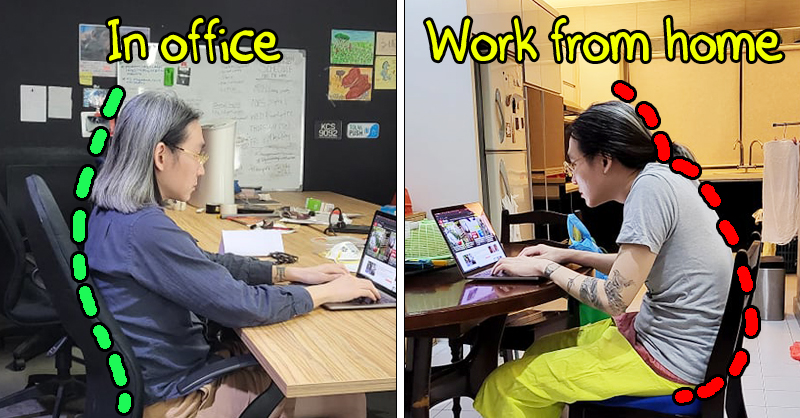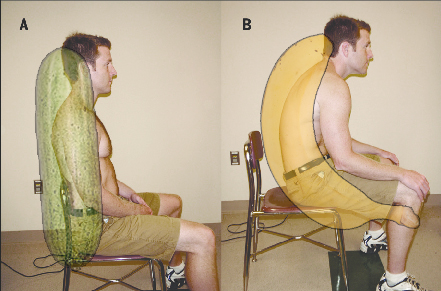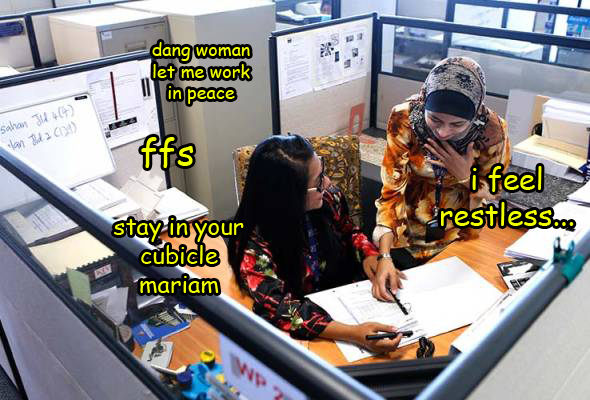A physiotherapist tells us how Malaysian bodies have changed after working from home

- 347Shares
- Facebook314
- Twitter7
- LinkedIn7
- Email6
- WhatsApp13
With more than 90% of the population kena cucuk already, things are starting to return to normal for most Malaysians. But if you’re one of those who have been working from home for the past year or so, have someone near you (or a webcam or a mirror) make this comparison: do you sit straight as a proud cucumber… or curved like a banana right now?

Yep, besides messing with the economy and our mental health, the past year or so of lockdowns had seemingly affected our bodies as well. In fact, the problem is so prevalent that people had come up with a specific term for it…
“Pandemic Posture”
Which we’ll be abbreviating to PP for comedic purposes. Anyways, to find out more about how PP are affecting Malaysians, we talked to Joesef Thomas, Senior Consultant and Head Physiotherapist at Bains Physio Hartamas. Perhaps surprisingly, he told us that in the past year…
Besides bad posture, patients came in with… thumb and knee pain?

PP refers to a range of necc and bacc issues that had been on the rise during the whole lockdowns and work-from-home periods, and while he had not been actively tracking the cases, he estimated that from over 100 patients he works with in a month, over 60% of them had PP-related issues. Besides the expected hunched postures, some of the more common cases he had been handling include:
- neck and back aches
- thumb pain
- pain and numbness in the arms and legs
- knee pain, and
- exercise injuries
So the neck and back aches and the numbness can be associated with sitting with a bad posture for too long, but what about the weirder stuff on that list? Well, Joesef told us that the thumb pain cases, suprisingly enough, is caused by repetitive scrolling on your smartphones, leading to strain in the thumb tendon. Which isn’t surprising considering that there’s nothing much else to do during the lockdowns.
Knee pain, on the other hand, had two factors. One is that when working from home, some people use the stairs a lot in their homes #2storeygang. The other is that when you frequently sit for too long, the muscles in the legs became weak and became unbalanced, causing pain. If you sit too long with a bad posture, the imbalance and pain will be worse.

As for the exercise-related injuries, he attributed them to people starting a home-workout regime without proper conditioning and guidance. These are pretty much relatable to most of us for the past year, so it’s no surprise that these problems popped up more now. But what about the rising PP cases? Surely working in the office is more taxing on the body than working at home?
Well, acktchually…
People tend to banana less in the office then at home

Most offices are, surprisingly, kinder to your body. Offices usually have a fixed workstation with ergonomic chairs and desks – for example, most office chairs’ height can be adjusted – but normal people usually don’t set up a proper place to work from home. Joesef tells us that this kind of arrangement happens because most people didn’t prepare and plan to work from home, or were guided for it: everyone was just in survival mode to work remotely.
With the MCO kept being extended during the past year, there was a sense of uncertainty of how long we’d have to work from home, so most of us didn’t see the sense in setting up a proper home office, thinking it’d be temporary. So we set up makeshift offices on our couch, the floor, the bed, the makeup table, the kitchen table, etc. However, many of these places aren’t designed for long hours of sitting and staring at a laptop, so our postures suffered.
Another factor leading to PP is that when you’re working from home, there are less distractions, so you tend to move less as well. In the office, there are colleagues to harass, gossip gatherings around the water cooler, smoke breaks, meetings in the meeting room, etc; but not so much at home. We end up sitting in the same position for hours on end, which contributes to PP.
Thankfully, these problems have some simple fixes.
Here’s how you can fix your posture at home

Posture might not seem like a big deal at first glance, but if left unchecked, it can cause aches and pains later on. Perhaps surprisingly, posture can also affect your mood. Ever heard that if you stand tall or smile, you’ll get more confident and happier? Well, the reverse is also true, according to Joesef: slouching and bad posture had also been linked to feelings of depression, so it’s worth being concerned about.
So whether you’re working at home or in the office, Joesef recommends some tips to help avoid PP:
1. Frequently remind yourself to fix your posture. This can be done by using visual cues, like sticking a note at the side of your computer screen where you might glance periodically, or by setting alarms at certain intervals. There are also apps that can do this.
2. Be mindful to avoid awkward postures. Whenever you feel like you’re sitting in an awkward position, fix it.
3. Schedule breaks for yourself and get moving. Joesef suggests getting up and walking for 1-2 minutes every 1-2 hours of work. There’s also something called the 20:20:20 rule, but it’s more for your eyes – every 20 minutes, look at something at least 20 feet away (about 6 meters) for 20 seconds.
4. Do a simple stretch two times a day – gently rotate your torso, then lean forwards, backwards and sideways.
5. Exercise whenever you feel stiff – Shrug your shoulders 5 times for 2 sets, then stand up and flex your knees while holding on to the back of your chair.
Now fix that posture!
- 347Shares
- Facebook314
- Twitter7
- LinkedIn7
- Email6
- WhatsApp13
